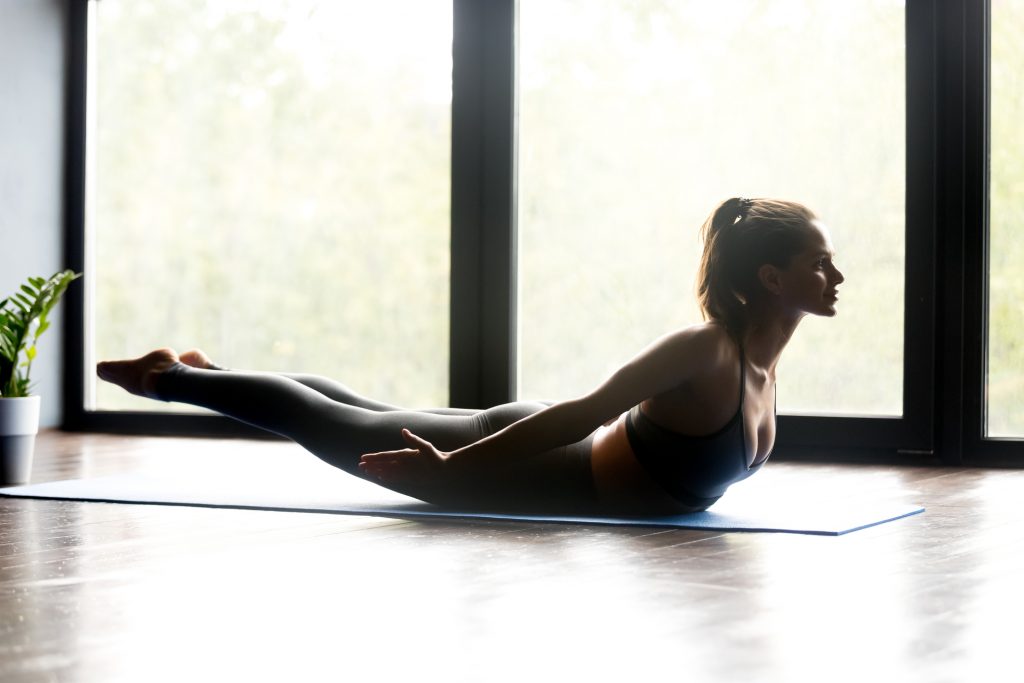Shalabasana: a simple step-by-step guide

Shalabasana is a pose from the asana family of soft backbends. Although it seems pretty easy to perform, it is, in fact, a quite challenging asana.
Also called the locust pose, it is a floor asana which focuses mainly on the back actions, but not only. Important to build the necessary flexibility and strength to move on to deeper backbends, it’s also included in the Ashtanga Series I.
Shalabasana has multiple variations, so you may have known it in different versions than the one we now explore, Shalabasana A, the Ashtanga version. Find all the steps and what are its benefits!
Shalabasana: step-by-step
Shalabasana is a preparation asana for deeper backbends, with a special focus on strengthening the back. Its inclusion at the beginning of practice focused on the lower back is an interesting option. It’s also a good option when working on building strength and can be included in different sequences.
For now, we present you the Ashtanga variation of Shalabasana A:
- Lying on your stomach, keep your pelvic bone against the floor and your feet together.
- Bring your arms along the body and turn your hands, palms facing up.
- Keep your back activated.
- Lift your head, chest, and legs, and keep your hands on the floor.
- Exhale and release all your body.
You can either opt to do it in a dynamic way and repeat the process for 3 to 5 times. Inhale to enter the pose and exhale as you release. Or you can enter the pose and hold for a minimum of 3 breaths. A third pose is also to repeat it dynamically a few times and then hold it, it will allow the back to warm-up before pushing further.

The benefits of Shalabasana, the Locust Pose
As previously mentioned, this pose is not a difficult, but it is challenging. Keeping all the alignment while holding the pose and breathing is not as easy as it seems. The good news is that the effort compensates, since Shalabasana has a good number of incredible benefits:
- The first and most obvious benefit is the strengthening of the back;
- It improves the posture;
- Stimulates the internal organs, activating the kidneys, liver and all the organs of the lower of the body;
- Tones the sciatic nerves.
Since the back is one of the main concerns in the practice, this pose is essential. A healthy spine is essential for a good life, for meditating and for a good flow of the energy in the subtle body.
In order to get into deeper backbends it’s not only important to have flexibility, but most of all strength. Therefore, this is a preparation asana for others like Ustrasana or Urdhva Dhanurasana.
Contraindications and precautions
Any health problems related to the abdomen or pelvic area must be considered before doing this pose. If you have any doubts, talk to a yoga teacher and a doctor, and look for other options. In the case of abdomen surgeries, make a complete recovery before going back to the pose, and start gently.
Shalabasana must also be avoided in pregnancy, when with headaches or migraines and must be carefully studied when in case of back or neck injuries. Put effort on this pose and enjoy all it has to benefit you!
You may also like:
- Yoga: the ultimate guide for types and benefits
- Malasana pose: why and how to include it in your daily routines
- Pascimottanasana: the West Back Stretching
- Urdhva Mukha Svanasana: get to know the Face-Up Dog Pose

